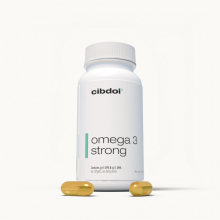Which Butter is High in Omega-3?
Published:
Omega-3 fatty acids are an important part of a healthy diet. They provide many health benefits, including reducing inflammation, lowering blood pressure, decreasing triglycerides, and improving brain function. While omega-3s are found naturally in some foods, like fish and walnuts, some butters have been fortified with omega-3s to help people meet their daily needs. So which butters contain high levels of omega-3 fatty acids?
Contents:

The Benefits of Omega-3 Fatty Acids
Before looking at omega-3 fortified butters, let's first understand why omega-3s are so important for health. Here are some of the top benefits provided by these healthy fats:
Reduce Inflammation
Omega-3s help reduce inflammation throughout the body. Chronic inflammation is linked to conditions like heart disease, cancer, arthritis, depression, and more. Getting adequate omega-3s can help dampen inflammation.
Improve Heart Health
Omega-3 fatty acids benefit heart health in several ways. They reduce triglycerides, lower blood pressure, improve artery function, and reduce irregular heartbeats. This all contributes to better cardiovascular health.
Enhance Brain Function
The omega-3 DHA is a major structural component of the brain. Omega-3s support optimal brain function and mental health. They may also help ward off dementia.
Alleviate Joint Pain
The anti-inflammatory effects of omega-3s can help minimize joint pain from arthritis. Both fish oil supplements and omega-3 rich foods can ease arthritis symptoms.
Fight Depression
Getting more omega-3 fatty acids in your diet may help lift your mood. Omega-3s assist in dopamine and serotonin production, helping to combat depression.
Omega-3 Content in Regular Butter
Before looking at specialty omega-3 fortified butters, let's look at the omega-3 content in regular butter. Unfortunately, regular butter is not a significant source of omega-3 fatty acids.
According to the United States Department of Agriculture (USDA), one tablespoon of salted butter contains just 24 mg of omega-3 fatty acids. Meanwhile, one tablespoon of unsalted butter contains 28 mg of omega-3s.
For comparison, the daily omega-3 recommendation for healthy adults from the Dietary Guidelines for Americans is 250 mg per day for EPA and DHA omega-3s. As you can see, regular butter provides only a fraction of that amount.
While butter does contain small amounts of the omega-3 ALA, this needs to be converted into EPA and DHA to provide full benefits. The conversion process is inefficient, so butter is not an optimal omega-3 source.
Overall, regular butter is high in saturated fat and is not a meaningful source of beneficial omega-3 fats. To get omega-3s from dairy, you'd be better off choosing yogurt or milk fortified with EPA/DHA.
Omega-3 Enhanced Butters
While regular butter doesn't offer much in the way of omega-3s, some companies now produce specialty butters that are fortified with EPA and DHA omega-3 fatty acids.
By adding marine-sourced omega-3s to butter, these products offer the great taste of butter along with the health benefits of omega-3 fats. Here are some of the top options:
Kerrygold Enriched Butter
Kerrygold makes an omega-3 enriched butter that contains 75 mg of ALA and 25 mg of EPA/DHA per serving. With a pleasant, creamy taste, this Irish butter provides omega-3s in each pat.
Maple Leaf Buttery Spread
Maple Leaf's buttery spread has a blend of canola oil, flaxseed oil, and algal oil that delivers 90 mg of omega-3 ALA and 10 mg of DHA per serving. It was developed by Dr. Cristina MacKay.
Fatworks Omega Spread
This omega spread from Fatworks contains a mix of butter, olive oil, flax oil, and fish oil. Each serving has 115 mg of total omega-3s, including 45 mg of DHA/EPA. It has a light butter flavor.
Lurpak Omega 3 Spread
Lurpak Omega 3 Spread provides 70 mg of ALA and 30 mg of EPA/DHA per serving. This spread has a creamy, buttery taste and texture. It's made from a blend of rapeseed oil and marine algal oil.
Alberta Grass Fed Omega Butter
From grass-fed cows, this Canadian butter contains omega-3s from algal oil and echium oil. It has 112 mg total omega-3s per serving, with 32 mg as DHA/EPA.
Bunny's Butter Omega Boost
Bunny's Butter adds algal oil and echium oil to regular butter to create an omega enhanced spread. Each serving has 120 mg total omega-3s, including 15 mg EPA/DHA.
Tips for Using Omega-3 Butter
Omega-3 enriched butter can be used just like regular butter. However, be mindful of how much you use, as these products are still high in saturated fat, even with the added omega-3s. Here are some tips:
- Use omega butters in moderation - stick to about 1-2 tsp per day.
- Try spreading on toast, muffins, rolls, waffles, pancakes, etc.
- Use for sautéing vegetables, eggs, meats, and more.
- Add a pat on top of cooked vegetables, potatoes, fish, chicken, steak, etc.
- Whip into mashed potatoes or other vegetable purees.
- Swap for regular butter in recipes like cookies, cakes, frosting.
- Mix into oatmeal, yogurt, cottage cheese, etc.
Focus on getting omega-3s from healthy whole foods like fish, walnuts, chia seeds, and oils like flaxseed oil. Use omega-3 butter sparingly as an addition to your diet.
Who Might Benefit from Omega-3 Butter?
While omega-3 enriched butter can be part of a healthy diet, it may provide extra benefits for some individuals:
- Those who dislike or are allergic to fish - the omega-3 butter offers an alternative omega-3 source.
- People following a vegetarian or vegan diet - it provides EPA/DHA which can be limited on plant-based diets.
- Individuals trying to increase omega-3 intake - the enriched butter makes it easy to add more omega-3s.
- Anyone seeking to reduce inflammation - the anti-inflammatory benefits of omega-3s are useful for many.
- People concerned with brain health - the DHA in omega-3 butter supports cognitive function.
- Those with heart disease risk factors - the EPA/DHA promote better cardiovascular health.
- Older adults - omega-3s support healthy aging, cognition, and longevity.
Of course, always chat with your doctor about whether omega-3 fortified foods align with your specific health needs and diet.
Downsides of Omega-3 Enriched Butter
While omega-3 fortified butter can be a convenient way to increase omega-3 consumption, there are some potential downsides to consider:
- Still high in saturated fat - omega-3 butter retains the high saturated fat content of regular butter. This type of fat can increase LDL cholesterol levels, so use in moderation.
- Lower omega-3s than supplements - enriched butters provide far less DHA/EPA than dedicated omega-3 supplements from fish, krill, algae, etc.
- Added cost - omega-3 butters are priced higher than regular butter, so they represent an added cost.
- Fat soluble vitamins lacking - butter has vitamins A, D, E and K, but omega-3 enriched varieties may be missing these fat soluble vitamins that are present in regular butter.
- Can be highly processed - some omega-3 enriched butters are heavily processed, stripping out some of the nutritional benefits of butter.
- Risk of rancidity - the added polyunsaturated omega-3 oils can increase the chances of the product going rancid faster than regular butter.
Overall, balance omega-3 enriched butters within your diet and rely on other healthier sources of omega-3 fats like salmon and walnuts as well. Moderation is key with these specialty products.
Top Omega-3 Whole Food Sources
To get beneficial omega-3s from whole foods, here are some of the top sources to include in your diet:
Fatty Fish
Fatty fish like salmon, mackerel, herring, tuna, and sardines are all excellent sources of DHA and EPA omega-3s. Aim for at least two 3-4 oz servings per week.
Walnuts
Walnuts offer a sizable amount of plant-based ALA omega-3s - about 2.5g per ounce. Enjoy a handful for a nutritious snack.
Chia and Flaxseeds
Both chia and flax provide plant-based ALA omega-3s. Try adding them to oatmeal, yogurt, smoothies, salads or baked goods.
Soybeans and Edamame
Cook up some edamame or add shelled soybeans to soups and salads for a plant-based dose of omega-3 ALA.
Canola Oil
Among cooking oils, canola oil has the highest ALA omega-3 content. Use for stir-fries, salad dressings, and homemade spreads.
Brussels Sprouts
This cruciferous veggie has a small amount of omega-3 ALA. Roast or sauté these mini cabbages.
Hemp Seeds
In addition to protein, hemp seeds offer omega-3 ALA. Add to smoothies, cereals, salads, and energy bites.
Kidney Beans
Beans deliver fiber and protein along with some ALA omega-3s. Incorporate beans multiple times per week.
Conclusion
Omega-3 fatty acids provide major health benefits, so getting adequate amounts is important. While regular butter is not a significant source of omega-3s, some fortified butter spreads contain EPA/DHA omega-3s. Options like Kerrygold, Maple Leaf, Lurpak, and Fatworks provide omega-3s alongside the rich taste of butter.
Used in moderation, these products can help increase omega-3 intake. But emphasize omega-3 whole food sources like fatty fish, walnuts, flaxseeds, and soybeans as the foundation. Enjoy omega-3 enriched butter sparingly to augment your diet and promote good health.










